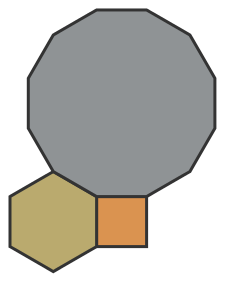How many ways can regular (convex) polygons meet at a point (vertex), so there are no gaps or overlaps? Reflections are considered indistinct.
Here's an example with a square, hexagon, and dodecagon.

How many ways can regular (convex) polygons meet at a point (vertex), so there are no gaps or overlaps? Reflections are considered indistinct.
Here's an example with a square, hexagon, and dodecagon.

Let nonnegative integer decision variable $x_k$ represent the number of $k$-gons. A necessary condition is that the internal angles sum to $360$ degrees: $$\sum_{k \ge 3} 180 \frac{k-2}{k} x_k = 360. \tag0\label0$$ I found
17 solutions to \eqref{0}:
\begin{align} &(x_{6}=3 )\tag{1}\label{1}\\ &(x_{5}=2 ,x_{10}=1 )\tag{2}\label{2}\\ &(x_{4}=1 ,x_{8}=2 )\tag{3}\label{3}\\ &(x_{4}=1 ,x_{6}=1 ,x_{12}=1 )\tag{4}\label{4}\\ &(x_{4}=1 ,x_{5}=1 ,x_{20}=1 )\tag{5}\label{5}\\ &(x_{4}=4 )\tag{6}\label{6}\\ &(x_{3}=1 ,x_{12}=2 )\tag{7}\label{7}\\ &(x_{3}=1 ,x_{10}=1 ,x_{15}=1 )\tag{8}\label{8}\\ &(x_{3}=1 ,x_{9}=1 ,x_{18}=1 )\tag{9}\label{9}\\ &(x_{3}=1 ,x_{8}=1 ,x_{24}=1 )\tag{10}\label{10}\\ &(x_{3}=1 ,x_{7}=1 ,x_{42}=1 )\tag{11}\label{11}\\ &(x_{3}=1 ,x_{4}=2 ,x_{6}=1 )\tag{12}\label{12}\\ &(x_{3}=2 ,x_{6}=2 )\tag{13}\label{13}\\ &(x_{3}=2 ,x_{4}=1 ,x_{12}=1 )\tag{14}\label{14}\\ &(x_{3}=3 ,x_{4}=2 )\tag{15}\label{15}\\ &(x_{3}=4 ,x_{6}=1 )\tag{16}\label{16}\\ &(x_{3}=6 )\tag{17}\label{17}\\ \end{align}
(Solution \eqref{4} corresponds to the example given in the question.)
Up to rotation and reflection, solutions \eqref{12} through \eqref{15} yield two arrangements, and the rest yield only one. So in total there are
$17+4=21$ arrangements.